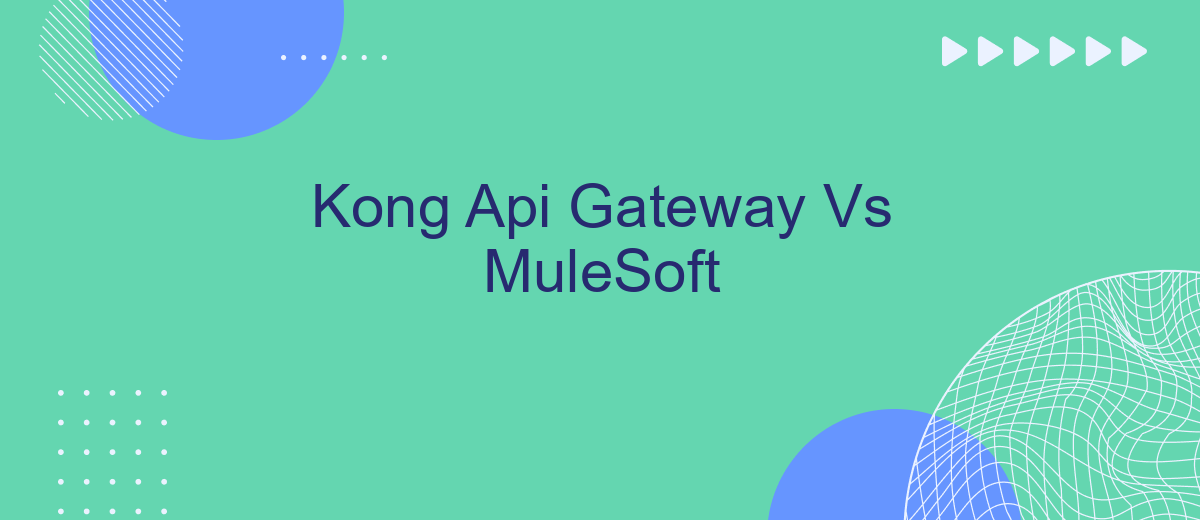In the rapidly evolving landscape of API management, choosing the right gateway is crucial for seamless integration and performance. This article delves into a comparative analysis of Kong API Gateway and MuleSoft, two leading solutions in the market. We'll explore their features, performance, and scalability to help you determine which platform best meets your business needs.
Introduction
In the rapidly evolving world of API management, choosing the right gateway is crucial for ensuring seamless integration and efficient performance. Kong API Gateway and MuleSoft are two prominent solutions that offer robust features for managing APIs. Understanding their key differences and strengths can help organizations make informed decisions based on their specific needs.
- Kong API Gateway: Known for its high performance and scalability, Kong is an open-source solution that excels in handling microservices and modern architectures.
- MuleSoft: A comprehensive integration platform that provides extensive tools for connecting applications, data, and devices, making it ideal for complex enterprise environments.
Both Kong API Gateway and MuleSoft offer unique advantages, and the choice between them often depends on the specific requirements of the project. For businesses looking to streamline their integration processes, tools like SaveMyLeads can further enhance the efficiency by automating lead data transfer between various platforms, ensuring a seamless and optimized workflow.
Capabilities and Features

Kong API Gateway offers a robust set of features designed to enhance API management, including load balancing, rate limiting, and authentication. It excels in providing high performance and scalability, making it suitable for enterprises with large-scale API traffic. Kong's plugin architecture allows users to extend its capabilities easily, and its open-source nature ensures flexibility and community support. Additionally, Kong supports both RESTful and gRPC APIs, offering a versatile solution for various integration needs.
MuleSoft, on the other hand, provides a comprehensive integration platform that goes beyond API management. It offers a wide range of connectors and integration templates, facilitating seamless connectivity between different systems and applications. MuleSoft's Anypoint Platform enables users to design, build, and manage APIs and integrations in a unified environment. For businesses looking to simplify their integration processes, services like SaveMyLeads can be beneficial, as they automate data transfer between different applications, reducing manual effort and increasing efficiency. MuleSoft's strong analytics and monitoring capabilities also provide valuable insights into API usage and performance.
Use Cases

Kong API Gateway and MuleSoft are powerful tools for managing and integrating APIs, but they serve different use cases. Kong is often preferred for its lightweight, high-performance gateway capabilities, while MuleSoft is known for its comprehensive integration platform that supports a variety of enterprise needs.
- Kong API Gateway is ideal for organizations that require a scalable and performant API management solution. It's commonly used in microservices architectures and for managing APIs in cloud-native environments.
- MuleSoft is best suited for enterprises needing to integrate a wide range of applications, data sources, and devices. Its robust features and connectors, including those for services like SaveMyLeads, make it a versatile choice for complex integration projects.
Both tools provide unique advantages depending on the specific requirements of the project. While Kong excels in API performance and scalability, MuleSoft offers extensive integration capabilities and out-of-the-box connectors that can streamline the integration process, including with services like SaveMyLeads to automate lead management.
Architecture and Deployment

Kong API Gateway and MuleSoft are two prominent solutions for managing and deploying APIs. Kong operates as a high-performance, scalable, and open-source API gateway, often deployed in cloud-native environments. MuleSoft, on the other hand, is a comprehensive integration platform that offers a unified approach to connecting applications, data, and devices.
The deployment architectures of these platforms differ significantly. Kong is typically implemented as a lightweight, containerized service that can be easily integrated with Kubernetes for dynamic scaling and management. MuleSoft's Anypoint Platform, however, is designed to be a full-fledged enterprise service bus (ESB) with extensive tools for API management, data integration, and orchestration.
- Kong: Lightweight, containerized, suitable for microservices.
- MuleSoft: Comprehensive ESB, ideal for complex integrations.
- Kong: Easily scalable with Kubernetes.
- MuleSoft: Extensive tools for API lifecycle management.
For businesses looking to streamline their integration processes, services like SaveMyLeads can complement these platforms by automating routine data transfers and integrations. This can significantly reduce the overhead involved in manual configuration and management, allowing teams to focus on core development tasks.
Conclusion
In conclusion, both Kong API Gateway and MuleSoft offer robust solutions for managing and integrating APIs, each with its unique strengths. Kong excels in performance and scalability, making it ideal for high-traffic environments and microservices architectures. Its open-source nature and extensive plugin ecosystem provide flexibility for developers looking to customize their API management solutions. On the other hand, MuleSoft's Anypoint Platform stands out for its comprehensive integration capabilities and user-friendly interface, which simplifies the process of connecting various applications and data sources.
Ultimately, the choice between Kong and MuleSoft depends on your specific needs and priorities. For organizations focused on seamless integration and a unified platform for managing APIs and integrations, MuleSoft is a compelling option. Meanwhile, Kong is an excellent choice for teams that prioritize performance, customization, and scalability. Additionally, leveraging services like SaveMyLeads can enhance your integration efforts by automating data transfers and streamlining workflows, further optimizing your API management strategy. Each tool has its advantages, and understanding your requirements will guide you to the most suitable solution.
- Automate the work with leads from the Facebook advertising account
- Empower with integrations and instant transfer of leads
- Don't spend money on developers or integrators
- Save time by automating routine tasks
FAQ
What are the primary differences between Kong API Gateway and MuleSoft?
Which platform offers better scalability?
How do they handle security and compliance?
Can they both integrate with existing systems and applications?
What are the options for automating and setting up integrations?
What do you do with the data you get from Facebook lead forms? Do you send them to the manager, add them to mailing services, transfer them to the CRM system, use them to implement feedback? Automate all of these processes with the SaveMyLeads online connector. Create integrations so that new Facebook leads are automatically transferred to instant messengers, mailing services, task managers and other tools. Save yourself and your company's employees from routine work.

